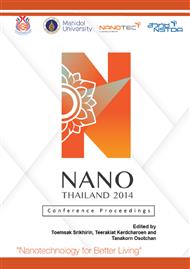[1]
WWAP, The United Nations World Water Development Report 4: Managing Water Under Uncertainty and Risk, in, UNESCO, Paris, (2012).
DOI: 10.18356/8bfd678c-en
Google Scholar
[2]
WWAP, The United Nations World Water Development Report 3: Water in a Changing World, in, UNESCO/ Earthscan, Paris/London, (2009).
Google Scholar
[3]
WHO, UNICEF, Progress on sanitation and drinking-water-2013 update: joint monitoring programme for water supply and sanitation, in, (2013).
Google Scholar
[4]
UNESCAP, Building Resilience to Natural Disasters and Major Economic Crises, in, UNESCAP, Bangkok, (2013).
Google Scholar
[5]
UN, The Report of the High-Level Panel of Eminent Persons on the Post-2015 Development Agenda, in, UN, New York, (2013).
Google Scholar
[6]
UN, Water scarcity, in, UN, (2014).
Google Scholar
[7]
WHO, UNICEF, Global water supply and sanitation assessment, 2000 report, in, (2000).
Google Scholar
[8]
R. Das, M.E. Ali, S.B. Abd Hamid, S. Ramakrishna, Z.Z. Chowdhury, Carbon nanotube membranes for water purification: A bright future in water desalination, Desalination, 336 (2014) 97-109.
DOI: 10.1016/j.desal.2013.12.026
Google Scholar
[9]
M. Ali, R. Das, A. Maamor, S.B.A. Hamid, Multifunctional Carbon Nanotubes (CNTs): A New Dimension in Environmental Remediation, Adv. Mater. Res. 832 (2014) 328-332.
DOI: 10.4028/www.scientific.net/amr.832.328
Google Scholar
[10]
R. Das, M.E. Ali, S.B.A. Hamid, S. Ramakrishna, Z.Z. Chowdhury, Carbon nanotube membranes for water purification: A bright future in water desalination, Desalination, 336 (2014) 97-109.
DOI: 10.1016/j.desal.2013.12.026
Google Scholar
[11]
R. Das, S.B.A. Hamid, M.E. Ali, A.F. Ismail, M. Annuar, S. Ramakrishna, Multifunctional carbon nanotubes in water treatment: The present, past and future, Desalination, 354 (2014) 160-179.
DOI: 10.1016/j.desal.2014.09.032
Google Scholar
[12]
S. Iijima, Helical microtubules of graphitic carbon, Nature, 354 (1991) 56-58.
DOI: 10.1038/354056a0
Google Scholar
[13]
V.K.K. Upadhyayula, S.G. Deng, M.C. Mitchell, G.B. Smith, Application of carbon nanotube technology for removal of contaminants in drinking water: A review, Sci. Tot. Environ. 408 (2009) 1-13.
DOI: 10.1016/j.scitotenv.2009.09.027
Google Scholar
[14]
G. Aragay, J. Pons, A. Merkoçi, Recent trends in macro-, micro-, and nanomaterial-based tools and strategies for heavy-metal detection, Chem. Rev. 111 (2011) 3433-3458.
DOI: 10.1021/cr100383r
Google Scholar
[15]
D.L. Nelson, A.L. Lehninger, M.M. Cox, Lehninger principles of biochemistry, Macmillan, (2008).
Google Scholar
[16]
F. Subrizi, M. Crucianelli, V. Grossi, M. Passacantando, L. Pesci, R. Saladino, Carbon Nanotubes as Activating Tyrosinase Supports for the Selective Synthesis of Catechols, ACS Catalysis, 4 (2014) 810-822.
DOI: 10.1021/cs400856e
Google Scholar
[17]
M.H. Siddique, C.C. St Pierre, N. Biswas, J.K. Bewtra, K.E. Taylor, Immobilized enzyme catalyzed removal of 4-chlorophenol from aqueous solution, Water Res. 27 (1993) 883-890.
DOI: 10.1016/0043-1354(93)90153-9
Google Scholar
[18]
B. Brena, P. González-Pombo, F. Batista-Viera, Immobilization of Enzymes: A Literature Survey, in: Immobilization of Enzymes and Cells, Springer, 2013, pp.15-31.
DOI: 10.1007/978-1-62703-550-7_2
Google Scholar
[19]
W. Feng, P. Ji, Enzymes immobilized on carbon nanotubes, Biotech. Adv., 29 (2011) 889-895.
Google Scholar
[20]
P. Asuri, S.S. Bale, S.S. Karajanagi, R.S. Kane, The protein–nanomaterial interface, Curr. Opin. Biotech. 17 (2006) 562-568.
DOI: 10.1016/j.copbio.2006.09.002
Google Scholar
[21]
Y. -M. Lee, O. -Y. Kwon, Y. -J. Yoon, K. Ryu, Immobilization of horseradish peroxidase on multi-wall carbon nanotubes and its electrochemical properties, Biotech. Lett. 28 (2006) 39-43.
DOI: 10.1007/s10529-005-9685-8
Google Scholar
[22]
Y. Liu, X. Qu, H. Guo, H. Chen, B. Liu, S. Dong, Facile preparation of amperometric laccase biosensor with multifunction based on the matrix of carbon nanotubes–chitosan composite, Biosens. Bioelectron. 21 (2006) 2195-2201.
DOI: 10.1016/j.bios.2005.11.014
Google Scholar
[23]
A. Guiseppi-Elie, C. Lei, R.H. Baughman, Direct electron transfer of glucose oxidase on carbon nanotubes, Nanotechnology, 13 (2002) 559.
DOI: 10.1088/0957-4484/13/5/303
Google Scholar
[24]
E.T. Hwang, M.B. Gu, Enzyme stabilization by nano/microsized hybrid materials, Engineering in Life Sciences, 13 (2013) 49-61.
DOI: 10.1002/elsc.201100225
Google Scholar
[25]
Y. Gao, I. Kyratzis, Covalent immobilization of proteins on carbon nanotubes using the cross-linker 1-ethyl-3-(3-dimethylaminopropyl) carbodiimide—a critical assessment, Bioconjugate Chem. 19 (2008) 1945-(1950).
DOI: 10.1021/bc800051c
Google Scholar
[26]
D. Nepal, K.E. Geckeler, pH‐Sensitive Dispersion and Debundling of Single‐Walled Carbon Nanotubes: Lysozyme as a Tool, Small, 2 (2006) 406-412.
DOI: 10.1002/smll.200500351
Google Scholar
[27]
P. Asuri, S.S. Karajanagi, E. Sellitto, D.Y. Kim, R.S. Kane, J.S. Dordick, Water‐soluble carbon nanotube‐enzyme conjugates as functional biocatalytic formulations, Biotechnol. Bioengin. 95 (2006) 804-811.
DOI: 10.1002/bit.21016
Google Scholar
[28]
W. Huang, S. Taylor, K. Fu, Y. Lin, D. Zhang, T.W. Hanks, A.M. Rao, Y. -P. Sun, Attaching proteins to carbon nanotubes via diimide-activated amidation, Nano Lett. 2 (2002) 311-314.
DOI: 10.1021/nl010095i
Google Scholar
[29]
K. Jiang, L.S. Schadler, R.W. Siegel, X. Zhang, H. Zhang, M. Terrones, Protein immobilization on carbon nanotubes via a two-step process of diimide-activated amidation, J. Mater. Chem. 14 (2004) 37-39.
DOI: 10.1039/b310359e
Google Scholar
[30]
N.S. Lawrence, R.P. Deo, J. Wang, Comparison of the electrochemical reactivity of electrodes modified with carbon nanotubes from different sources, Electroanalysis, 17 (2005) 65-72.
DOI: 10.1002/elan.200403120
Google Scholar
[31]
R. Das, M.E. Ali, S.B.A. Hamid, M.S.M. Annuar, S. Ramakrishna, Common Wet Chemical Agents for Purifying Multi-Walled Carbon Nanotubes J. Nanomaterials, In Press (2014).
DOI: 10.1155/2014/945172
Google Scholar
[32]
M.S. Mauter, M. Elimelech, Environmental applications of carbon-based nanomaterials, Environ. Sci. Technol. 42 (2008) 5843-5859.
DOI: 10.1021/es8006904
Google Scholar
[33]
B.P. López, A. Merkoçi, Improvement of the electrochemical detection of catechol by the use of a carbon nanotube based biosensor, Analyst, 134 (2009) 60-64.
DOI: 10.1039/b808387h
Google Scholar


